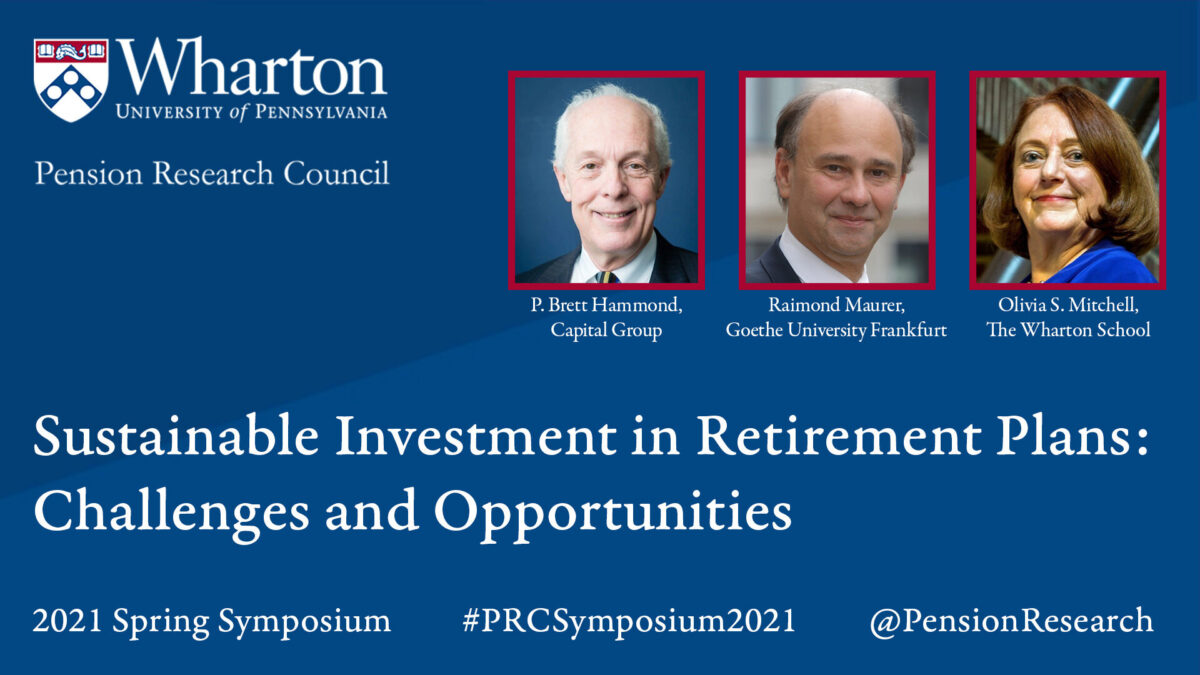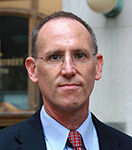
On April 29-30, 2021, the Wharton Pension Research Council held its annual symposium, “Sustainable Investment in Retirement Plans: Challenges and Opportunities.”
Cohosted by Brett Hammond of Capital Group, Raimond Maurer of Goethe University Frankfurt, and Wharton Prof. Olivia S. Mitchell, this was the second time the conference was held online.
Session I, moderated by Olivia S. Mitchell, was “ESG Objectives, Measurements, and Outcomes.”


Brett Hammond of Capital Group and Amy O’Brien of Nuveen, a TIAA Company, presented “Pensions and ESG: Institutional and Historical Perspective.” Funded pensions were among the first institutions to respond to sustainability concerns, and these are showing renewed interest in better ways to reflect responsible investing objectives, along with regulators, asset managers, and shareholder groups. Looking back, the principal elements of sustainability—environmental, social, and governance (ESG)— have different origins, and interest in sustainable investing has developed differently depending on region and country. Viewing it today, we see the trend toward ESG convergence in definition, process, and organization, toward a more integrated investment perspective and process. Over time, as assets grew, funded pensions, sovereign wealth funds, and other large institutional investors have become “universal owners” driving the evolution of sustainable investing toward a more systematic set of tools and policies seen today. Looking forward, questions remain, including who will be most influential in determining the future of sustainable investing, as well as what it will become. As such, sustainability remains a work in progress and pensions are in a strong position to shape its evolution.

Linda-Eling Lee of MSCI, Inc. presented “What Does ESG Investing Really Mean? Measuring Materiality.” This presentation reports on what environmental, social, and governance (ESG) investing means. While some institutions have articulated their objectives clearly, there remains confusion over what ESG investing is and how to implement it. Some hurdles include a lack of understanding and confidence in how ESG concepts are measured, when such concepts are material and how to work with ESG data in the investment process. In this paper, we address these hurdles by providing an overview of the “state of play” on ESG data. We focus on recent advances in measuring ESG concepts and on emerging evidence on the link between ESG and financial performance of equities and corporate bonds. Lastly, we discuss approaches that funds have used to implement their ESG policies in light of these advances.
Session II, moderated by Joel Dickson of the Vanguard Group, was “Evolution of ESG Investing in Pensions.”

Christopher Geczy of The Wharton School presented “Would ESG Performance Enhance Pension Performance? An Expectations Perspective,” coauthored with John Guerard of McKinley Capital Management LLC. In equity portfolio construction, ESG characteristics interact with securities’ expected returns depending on how those returns are modeled. For example, ESG ratings are associated with a quality factor in returns, which is positively correlated with earnings forecast depth and breadth, and negatively associated with profitability. Some ESG ratings are more impactful than others on information ratios defined by popular multifactor models. We discuss the implications for fiduciaries required to compare expected returns of alternative investments holding risk constant.


Stéphanie Lachance of PSP Investments and Judith Stroehle of Saïd Business School, University of Oxford, presented “The Origins of ESG in Pensions: Strategies and Outcomes.” Many pension funds have good reasons to embrace a sustainability lens in their investment practice, including the long-term management of corporate risks and opportunities in living up to their responsibilities as intergenerational stewards of capital. Nevertheless, the particular structure of pension funds creates a set of both advantages and disadvantages for the integration of ESG, compared to other institutional investors. This paper reviews the historical origins, mandates, and structures of pension funds to tease out exactly which of these characteristics enable and which of them impede the inclusion of ESG criteria in pension investments. We link individually and collaboratively constructed strategies to these markers, to understand which sustainability outcomes are pursued, and which pension funds are best positioned to achieve them.

Laura Starks of the University of Texas at Austin McCombs School of Business presented “ESG and Downside Risks: Implications for Pension Funds” coauthored with Zacharias Sautner of the Frankfurt School of Finance & Management. We discuss the implications of environmental, social, and governance (ESG) risks for pension fund portfolios. In view of most defined benefit pension plans’ long-term horizons, such institutions face key exposure to the long-lived effects of many ESG risks, especially those related to climate change. The potential consequences of being underfunded also leaves pension funds particularly exposed to ESG-related downside risks, especially sharp declines in asset values. Focusing particularly on downside risks in the face of climate change, we provide evidence on institutional investors’ perspectives regarding climate-related risks and how these are priced in financial markets. We also present evidence on whether and how institutional investors address climate-related risks in the investment process, with a focus on the role of engagement versus divestment.

Roberto Rigobon of the MIT Sloan School of Management presented “ESG Confusion and Stock Returns: Tackling the Problem of Noise.” “Transforming firms’ ethical behavior should be our first priority.”
Session III, moderated by Julia Coronado of MacroPolicy Perspectives, was “ESG Impacts on Pension Governance, Investments, Structures, and Reporting.”

Rob Bauer of Maastricht University and the International Centre for Pension Management presented “Eliciting Pension Beneficiaries’ Sustainability Preferences: Why and How?” coauthored with Paul M.A. Smeets of Maastricht University. Boards and managers of defined benefit and defined contribution retirement plans are increasingly interested in the integration of socially responsible investment attributes into pension plan design and long-term investment strategies. A key element in this process is to address the question of how pensions should condition their design and investment solutions based on plan participants’ preferences and beliefs. Our discussion reviews several recent academic articles focusing on pension funds in various jurisdictions that seek to elicit the true preferences and beliefs of beneficiaries, using field experiments and similar methods, regarding responsible investments. We summarize the results of these studies, draw out potential consequences for pension design and investments of retirement plans, and discuss the legal dilemmas that boards will encounter in the process.

Luba Nikulina of Willis Towers Watson presented “Global Pensions and ESG: Is There a Better Way?” This paper explores whether global pension funds are responsible for examining the impact of investments and systemic ESG engagement. Aside from government spending, global pension assets represent the largest pool of capital on the planet, with the longest time horizons and multiple stakeholders of different generations. The potential influence of this capital base is enormous, and many of the world’s global challenges can only be solved with an intergenerational mindset. Yet for this to happen, pension funds must undergo a transformational change strengthening their governance, enhancing system-wide collaboration, and investing in innovation.

Gerben de Zwart of APG presented: “Redefining Performance for Sustainable Pension Investing.” Institutional investors are increasingly altering their investment portfolios to make them more sustainable, yet there is a wide diversity of opinions about what constitutes a responsible and sustainable investment. As a result, peoples’ decisions can easily lead to investment portfolios that are significantly different from both each other, as well as from the market. This insight suggests a need for defining success differently in the pension arena. To this end, we introduce a universal benchmarking approach that can help evaluate performance within the context of sustainability constraints set by the asset owner. This approach takes into account a clear division of responsibilities between asset owners and asset managers, and it can be applied to both passive and actively managed portfolios. It also offers insight into the impact of the sustainability choices made by asset owners, and financial investment decisions by investment managers.

Susan Gary of the University of Oregon School of Law presented “Conflicts and Opportunities for Pension Fiduciaries in the ESG Environment.” Acting as prudent investors, pension fiduciaries must consider all financially material factors that affect the risk/return profile of funds. Material ESG factors may affect financial performance by identifying opportunities and risk, so it would seem prudent to consider those factors when making decisions in the best interests of plan beneficiaries. The US Department of Labor issued a proposed rule in June 2020 that appeared to have the goal of curtailing consideration of ESG factors. In our view, the proposed rule was based on a misunderstanding of current investment strategies, resulting in a detrimental effect on the security of retirement funds. After a deluge of comment letters, the Labor Department issued a new rule that again permits pension fiduciaries to use all financially material information in making investment decisions. This paper examines the fiduciary duties that apply to those who manage pension funds, drawing on the history of social investingand exploring reasons that some suspect ESG investing necessitates a financial cost to the portfolio. After reviewing fiduciary investing principles from 1994 through 2021, we discuss challenges and opportunities for pension fiduciaries and look ahead to possible future guidance.
Session IV was Roundtable/Case Studies, moderated by Raimond Maurer of Goethe University Frankfurt.
 Nathan Fabian of Principles for Responsible Investment
Nathan Fabian of Principles for Responsible Investment
“Pension systems in the US, Australia, and UK face structural challenges which limit their ability to contribute to desirable economic, social, and environmental outcomes. How far should we go in restructuring?”
 Mike Garland of the NYC Comptroller Employees’ Retirement System
Mike Garland of the NYC Comptroller Employees’ Retirement System
“With responsibility for providing retirement security for many decades to come, New York City’s Retirement Systems are committed to serving as ‘active owners’ to promote sustainable business practices at portfolio companies.”
 Anita Margrethe Halvorssen of Global Legal Solutions, LLC: “How the Norwegian SWF Balances Ethics, ESG Risks, and Returns: Can this Approach Work for Other Institutional Investors?”
Anita Margrethe Halvorssen of Global Legal Solutions, LLC: “How the Norwegian SWF Balances Ethics, ESG Risks, and Returns: Can this Approach Work for Other Institutional Investors?”
“The Norwegian SWF is a good model for institutional investors: think long-term!”
The conference also featured two keynote speakers. Tetsuya Oishi of the Japanese Government Investment Pension Fund presented “The Role of Green Finance in Pension Investment,” and Billy Nauman of Moral Money/Financial Times discussed “Integrating Sustainability into Investment Analytics: What the Market is Telling Us.”
Many thanks to our participants and attendees for another informative conference.


